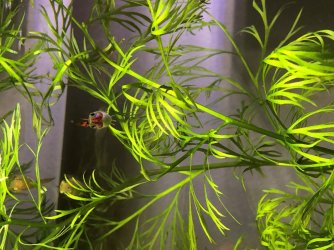I've had a guppy about 2-3 weeks, its been seeming fine. It overate due to my error one day so i seperated it into a 3 gal for 2 days without feeding. previously the small hospital tank had some baby platies i was keeping seperate to feed. I have put the guppie back in its main tank and it has super red gills seeming fairly normal but the gills are very red. The other guppie i have is staying in one place in the top of the tank now (weird) but was acting normal earlier. Both guppies are not acting normal. water reads 0 ammonia(test is odd and can be a little green tinted so I plated it safe and did water change added some seachem prime. 0 nitrite 0 nitrate Ph-6.8-7.4 PLEASE HELP I LOVE THEM
(other fish in 10 gal include 2 african dwarf frogs 1 baby platy)
(other fish in 10 gal include 2 african dwarf frogs 1 baby platy)



